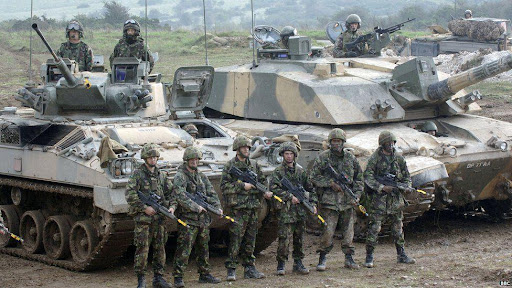The global political climate affects how states construct their militaries. This article ranks the top 10 militaries in the world in 2023. Many factors, including financial backing, manpower, technological sophistication, and general war readiness, all contribute to where we place ourselves.
1. United States Army
The United States Army is one of the biggest in the world, with nearly 1,300,000 active-duty personnel. It is a highly adaptable force that can respond swiftly to any threat because of the addition of 800,000 men from the Army National Guard and Army Reserve. Modern, highly effective weapons are a trademark of the United States Army. It has a diverse arsenal that includes tanks, artillery, and aircraft thanks to its heavy investment in cutting-edge R&D to stay at the forefront of the military technological race. The training that U.S. Army personnel undergo is among the most rigorous and extensive in the world. The United States Army has a long tradition of military success. From its role in the American Revolution to its current operations in Iraq and Afghanistan, the United States Army has been at the forefront of international military operations. It also contributed to the development of military doctrines and techniques that are still in use today.
One of the United States’ greatest strengths is the army’s capacity to project power anywhere in the globe. In order to quickly react to any danger or crisis, no matter where it may occur, the United States Army has created bases in over 80 nations. Among armed forces, the United States Army is often regarded as the most fearsome owing to its capacity to project power.

2. Russian Army
The Russian Army, or the Russian Ground Forces as they are formally called, is a formidable military force. Russia relies heavily on this branch of the armed forces to protect its borders and outside interests. It is widely acknowledged that the Russian Army is one of the best in the world, with over 400,000 regulars and over 2 million reserve personnel on hand. Its budget of about $60 billion is far less than that of the U.S. Army, yet it still provides for significant expenditures in modernization and research.Tanks, artillery, and airplanes are only some of the weaponry available to the Russian Army. The Iskander and Kalibr missile systems are two examples of Russia’s cutting-edge missile technology, both of which are capable of striking far-off targets. Significant funds are being invested by the Russian Army on cutting-edge weapon systems like the Armata tank and the S-500 air defense system in an effort to improve the force’s overall effectiveness. Toughness and perseverance are two qualities that the Russian military is known for. Its warriors undergo rigorous mental and physical preparation, including instruction in hand-to-hand combat and survival techniques. Also, the Russian Army is known for excelling in challenging environments like the Arctic. Russia’s army has a rich and storied past, highlighted by the decisive role it played in the defeat of Nazi Germany in World War Two. It has also supported the government of Bashar al-Assad in Syria and other conflicts across the world.

3. Chinese Army
China has one of the largest armies in the world, which is officially known as the People’s Liberation Army (PLA). It is responsible for defending China’s borders and national interests abroad and is the primary ground combat branch of the Chinese Armed Forces. The Chinese Army, with its over 2 million active-duty personnel, is the largest military in the world. With almost $178 billion, it has the second-largest budget in the world, behind only the United States. This allows for massive expenditures in expansion and modernization.
Tanks, artillery, and airplanes are just some of the tools at the Chinese army’s disposal. China is investing heavily on state-of-the-art missile defenses, such as the Dongfeng long-range ballistic missile system. Next-generation weapon systems, such the Chengdu J-20 stealth fighter and the Type 055 destroyer, are currently under development by the Chinese Army and are expected to increase its military capabilities.

3. British Army
When it comes to preserving British territory and interests abroad, the British Army is your go-to ground force. With a history extending back to the seventeenth century, it is one of the world’s oldest and most experienced forces. More than 80,000 regular soldiers and another 30,000 reserve personnel make up the British Army. Ireland has the fourth largest military budget in the world, at over £41 billion. Large sums of money may then be invested on enhancements and expansion.
The British Army uses a wide variety of weaponry, including tanks, artillery, and aircraft. Its long-range missile systems, such the Brimstone and the Storm Shadow, are well-known for their cutting-edge technology. However the British Army is investing heavily in next-generation weapon systems like the Ajax armored vehicle and the Future Soldier program, both of which should increase the country’s military might. The British Armed Forces have a sterling reputation for competence and professionalism throughout a wide range of military endeavors. Its warriors undergo rigorous mental and physical preparation, including instruction in hand-to-hand combat and survival techniques. Apart from that, the British Army is well-known for its efficiency in a wide range of environments, from the Arctic to the desert.

4. German Army
The German Army, as the primary ground combat force of the German Armed Forces, is tasked with protecting Germany’s borders and foreign interests. It’s one of the world’s most technologically sophisticated militaries, with a history stretching back to the 18th century. The current German army consists of over 180,000 active duty troops and about 30,000 reserve soldiers. Extensive renovations and expansion are possible because to the almost €45 billion in funding that has been allotted. The German armed forces are famous for their cutting-edge technology and weaponry, such as the Leopard 2 tank, Puma armored vehicle, and Eurofighter Typhoon fighter aircraft.
Soldiers in the German Military Forces endure rigorous mental and physical training, making them a highly professional and well-trained organization. The German army has a complicated history that includes two world wars. After WWII, Germany’s armed forces were significantly downsized and reorganized so that they could serve solely as a last line of defense. German troops have been sent to a wider range of countries and regions in recent years as part of the country’s armed forces’ increased involvement in international humanitarian and peacekeeping missions.

5. South Korean Army
The South Korean Army, formally known as the Republic of Korea Army (ROKA), serves as the backbone of the Korean government’s land forces. Partitioning the Korean Peninsula during WWII ultimately led to the founding of the modern state of North Korea in 1948. South Korea has approximately 500,000 people serving in the military, making it one of the largest in the world. Male citizens between the ages of 18 and 28 are conscripted into the army for a period of around two years. A soldier may choose to join the military full-time after this period.
South Korean troops make use of cutting-edge hardware including the K2 Black Panther main battle tank, the K9 Thunder self-propelled howitzer, and the K11 dual-barrel airburst weapon. It has a wide variety of specialist units, including the 707th Special Mission Battalion, which handles anti-terrorist and hostage rescue missions. In addition to its domestic responsibilities, the South Korean Army has participated in UN-backed international peacekeeping operations. From Iraq and Afghanistan to the Philippines and the Dominican Republic, South Korean troops are stationed all over the world.
With tensions escalating with North Korea, the South Korean Army is also vital to the country’s military strategy. South Korea’s armed forces are responsible for defending the country’s borders and interests against any North Korean invasion, since the Korean War was never formally declared over. This has resulted in the South Korean Army keeping a sizable presence in the DMZ (the area between the two Koreas).

Conclusion
Ultimately, there is a great disparity between the armed forces of different countries, both in terms of size and strength and in terms of the capabilities they can deploy. Every army has its place in national defense and security, and each has advantages and disadvantages.
About Author: The content is written by Maha. She has five years of experience in writing news and informative articles.














